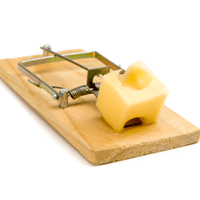
The Art of Setting Traps
Most tournament players scoff at the notion of Coffeehouse Chess. Even so, some of the most famous brilliancies in chess history were produced under dubious, non-tournament circumstances: The Immortal Game (Anderssen-Kieseritzky) was played at the Simpson's Grand Divan Tavern during a break in the London International Tournament, the Polish Immortal (Miguel Najdorf's four-piece-sacrifice gem against the shadowy Glucksberg) took place during unknown circumstances in Warsaw, and Morphy's iconic victory against Duke Karl of Brunswick and Count Isouard, arguably the most famous chess game of all time, found its genesis in the Paris Opera House during a production of Norma.
Clearly, this trend is not coincidental: in tournament play, you cannot afford to lose fifteen games just to produce one memorable combination; as Australian IM and Correspondence GM C.J.S. Purdy once remarked, "you aren't playing in a tournament to paint pictures, but to win points." Furthermore, the victims of these storied sacrificial barrages helped make them possible through their unsuspecting (and sometimes outrageously cooperative) play. In the Anderssen-Kieseritzky game, for instance, Black had multiple opportunities to punish White for his overambitious, tactically unjustified plan.

However, I believe that it is important to recognize that the old masters' (Anderssen, Morphy, Lasker, Zukertort, etc.) tactical cunning should not be written off as a thing of the past. To be sure, there is a fundamental difference between guile and cheapery. The famed romantics, for the most part, set tactical traps at the expense of their position. They got away with their highly dubious play - and won a myriad of brilliancy prizes in the process - due to their opponents' poor defensive ability. Nowadays, you will doubtless be punished for such unobjective play (remember that defensive ability has vastly improved in 150 years!), but there is no reason that tactical guile, per se, should be avoided.
It is tempting to think that Grandmasters win most of their games through subtle positional maneuvering, but this is not the case. There is nothing inherently cheap or wrong about setting a trap if it does not harm your position, and Grandmasters score many points (especially against lower-rated players) due to the tactical unpreparedness or naiveté of their opponents.
Let us start with an introductory example. What do I mean by tactical slyness? How exactly do you set a trap without disturbing the flow of the game?
After playing the opening and middlegame in a passive, distracted manner, I found myself struggling to stay afloat in this endgame. Black has an imposing pawn mass on the kingside, his pieces are beautifully coordinated, and White's own position is a mass of weaknesses and unsupported pieces. To this end, neither 31.Nxe7+ Rxe7 32.Rd1 a5 nor 31.Rd1 Bxh4+ 32.Kg2 Bd8 33.Nb4+ Kb7 34.c6+ Kc8 promise any relief for White. Thus, I arrived at my next move by process of elimination - the knight must be removed from d5, and this retreat must come with a gain of tempo (since 31.Nf4 Bf6 fails to impress). I was rather pleasantly surprised when I realized that this move also contains a vicious trap:
As you can see, 31.Nb4+ was objectively the best move. It was played not with the specific intention of provoking 31...Kb5, but to drive away Black's threatening monarch and thereby keep White's flimsy position together. Thus, at a high level, a trap is frequently contained within an entirely natural move.
Of course, to set a trap, you must be tactically alert at all times. The a4+, Bd2 idea was not particularly difficult to see (even if the rook was left en prise), but not all tactical operations are so short and convincing. In the following game, English GM Matthew Sadler had to rely on his calculational ability to trick his unsuspecting opponent, and follow up with impeccable technique to actually bring in the full point.
But what does Black do now? 23...Nb4 is the obvious move, but Black is not able to untangle himself: 24.Qd4 Rb3 25.Nd7! Nc6 (25...Rd8 26.Nf6+) 26.Qc4 R8b7 27.Qxa6 and Black's position collapses. An interesting idea is 23...Qg5, counterattacking White's knight, but 24.exd5 Qxe5 25.d6 dooms Black to a rather colorless existence - it is not clear how to deal with the far-advanced passer. Still, Sadler did not panic. He noticed that the scope of the b2 rook would be greatly increased if White's kingside pawn structure were compromised. For instance, if White's f-pawn could be eliminated, moves such as ...Qf6 or ...Qg5 would be very difficult to deal with. Is there a way to turn this dream into reality? You bet!
Once again, notice that 22...Nd5 was a strong move in and of itself; even if 23...Ne3 was impossible, he could have attained an immediate draw with 23...R8b4.
One other type of common trap to which I would like to draw your attention is what I call the "inertia trap." The name is more or less self-explanatory: at times, your opponent is so engrossed in executing a plan or intensifying an attack that he fails to spot a potentially decisive tactical subtlety. When you are on the verge of breaking through, it is remarkably easy to underestimate the potency of your opponent's defensive chances. The following game is a gem of an illustration:
Hopefully, you now have a firm grasp on my main point: that the art of setting traps - also known as chess cleverness - should be built into your play. When all is said and done, a victory achieved through a devious trap and a victory achieved through a mesmerizing combination are represented by the same number: 1. I will leave you with a particularly memorable trap. This is how cunning strong players can get!
RELATED STUDY MATERIAL
- Read GM Serper's article Tactical Patterns Everyone Should Know: The Siberian Trap;
- Watch IM Valeri Lilov's video Opening Traps for Beginners: Liver and Lolli!;
- Rescue the lady? Or is our princess in another castle? Find out in Chess Mentor;
- Become a tactical machine with our Tactics Trainer;
- See a preview of our magazine: The Master's Bulletin.

